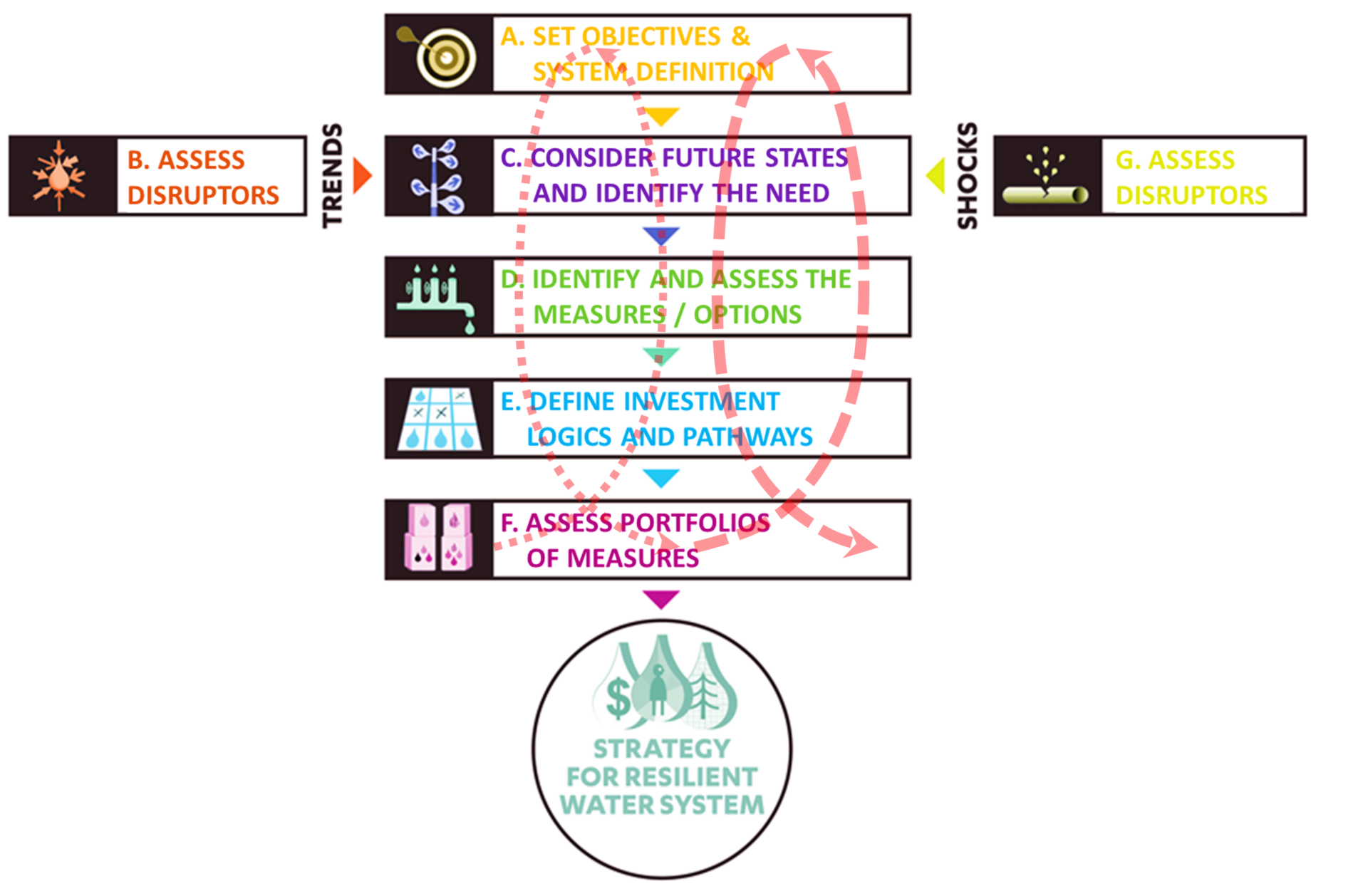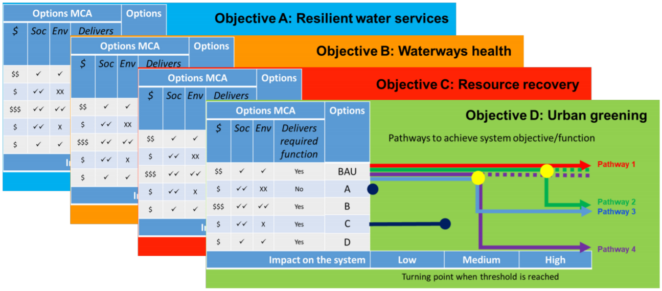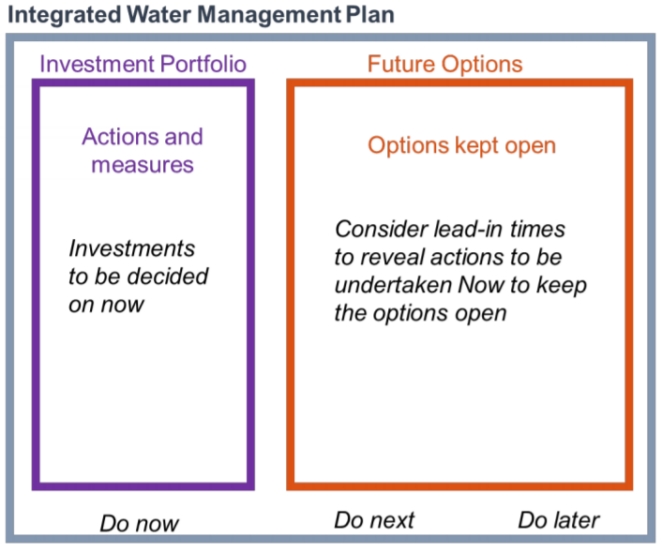Article /
Managing uncertainty under multiple drivers and disruptors

Introduction and Problem Definition
Urban water utilities and local councils are facing multi-dimensional challenges in planning integrated water service delivery strategies. As well as their regulated objectives, there are increasing expectations to address other drivers such as greening and resource recovery. While currently unresolved, these objectives are likely to become important in the future. In addition, planners aim to delivery water services under an increasingly uncertain future (such as climate and population growth) and a range of potential external disruptors (such as technological advances and changes in delivery models). This presents a new and complex challenge for the water industry.
*Download the full poster from the right-hand column.
Adaptive Planning Approach
Building on our experience with adaptive planning for water security, we have developed a Multi-Objective Adaptive Planning Framework (Figure 1) to meet the range of service delivery objectives in providing Integrated Water Management (IWM) in urban areas. This includes incorporating responsive and adaptive planning techniques to manage the variety of future uncertainties, together with assessment methods for valuation and trade-off considerations in the analysis of potential options and portfolios. The iterative nature of the approach generates flexibility to incorporate new information and circumstances.
Specifically, the Framework introduces innovation in a number of key areas:
- Using external system disruptors to identify significant trends and shocks – to test the portfolios of options for flexibility.
- A range of investment logics are used to assemble initial portfolios to explore the spread of possible solutions
- Forecasting techniques that utilise pathways methods to sequence the options over time in response to shortfalls (in meeting multiple objectives) under future disruptions, focusing on what needs to be now, and should be done next, and what can be done later.
- Backcasting techniques (also utilising pathways) to identifying actions for keeping options open for the future the actions that need to done now to avoid lock-out of particular options.
Future trends and shocks to a system can be identified by considering mega-trends and related external system disruptors, internal system drivers and uncertainties operating at various scales (spatial and temporal). We separate out the possible future trends (gradual changes over time where the rate of change is not known such as population growth or climate change) from the possible shocks to the system (sudden changes that introduce a new normal such as bushfires or technological advances). We use the prioritised trends to develop a wide range of possible future states, and the prioritised shocks for sensitivity checking the preferred portfolio of measures developed.
The investment logics guide the manner in which certain measures are prioritised over others, e.g. such a policy might be to build small incremental measures (decentralised/distributed recycling) as new developments occur, or alternatively to concentrate on centralised measures (large scale dual reticulation reuse schemes, large desalination) as a priority. It prescribes what types of measures are considered in the portfolio, who might be involved in delivering them, and who benefits and who pays.
The sequencing of measures over time in response to shortfalls (in meeting multiple objectives) under combinations of the disruptors and keeping measures available for future deployment will have a bearing on the cost and potential trade-off between objectives. The key question being: when to activate the measures and how to keep options open?
To define the sequencing of the measures, we propose using a pathway approach, first as a participatory tool and later analytically. The aim being to arrive at a range of possible portfolios, each with activated actions and measures as well as others that are kept open for potential activation in the future.
The pathways approach will enable us to see how some actions now keep opportunities open for the future – and avoid lock-out or lock-in of particular measures.
By considering the various pathways to achieve a number of objectives (sometime in competition with each other) and in response to various combinations of disruptors, synergistic pathways can be identified (Figure 2). This process will reveal investment portfolio that needs to be implemented in the near term, and actions that may need to be considered now in order to maintain the viability of potential future options.

Outcomes
The outcome is an adaptive Integrated Water Management plan for an urban region that comprises (Figure 3):
- An Investment Portfolioof actions and measures to be decided on now for the current iteration of the plan, and
- Future Optionsthat are being kept open for consideration when new information is at hand and/or when an objective failure is triggered.

This plan should include the actions taken straight way as well as triggers for measures that will account for lead-in times for the delivery, and the key indicators that will need to be monitored (These should be captured an Implementation, Monitoring, and Evaluation plan).
Critically, such an adaptive planning approach must involve active monitoring and review. This will be both the assessment of the agreed plan against indicators for change in the system disruptors, and the cyclical revision of the plan, based on new knowledge and changes in significant trends.
References
- Fane S, Mukheibir P, Prentice E & Chong J. (2017) External Factors for the Melbourne Sewerage Strategy 2018, [prepared for the Melbourne water utilities], UTS-ISF [closed access]
- Haasnoot M, Kwakkel J & Walker W. (2013) Dynamic adaptive policy pathways: A method for crafting robust decisions for a deeply uncertain world, Global Environmental Change, vol. 23 (2), 485-498 [open access]
- Kingsborough A, Borgomeo E & Hall J. (2016) Adaptation pathways in practice: Mapping options and trade-offs for London’s water resources, Sustainable Cities and Society vol. 27, P 386-39 [closed access]
- Manocha N, & Babovic V. (2017) Development and valuation of adaptation pathways for storm water management infrastructure, Environmental Science and Policy, vol. 77, p 86–9 [closed access]
- Mukheibir P & Mitchell C. (2011) Planning for resilient water systems – a water supply and demand investment options assessment framework [prepared for the Melbourne water utilities], UTS-ISF
Suggested citation
Mukheibir, P., and Fane, S., 2018. Managing uncertainty under multiple drivers and disruptors. UTS-ISF.
Further reading
- The Uncertainty Handbook: A Practical Guide for Climate Change Communicators
- Facing Uncertainty: the value of climate information for adaptation, risk reduction and resilience in Africa
- Moving through uncertainty, toward Research for Impact
- Robust Decision Making (RDM)
- MEDIATION Briefing Note on Mulit-Criteria Analysis: Decision Support Methods for Adaptation
- NeWater project main page New Approaches to Integrated Adaptive Water Management
